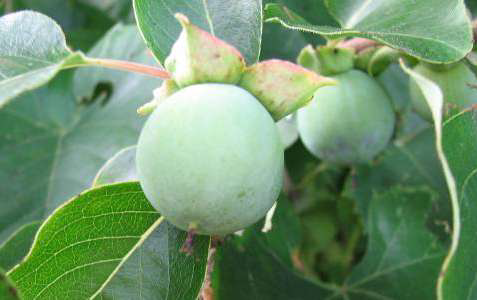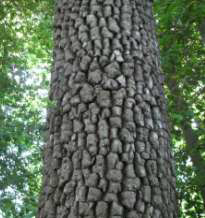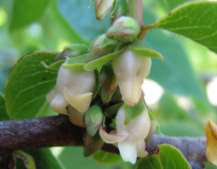 Persimmon
Persimmon
(Diospyros virginiana L.)
|
Classification |
| Kingdom: |
Plantae |
| Division: |
Magnoliophyta |
| Class: |
Magnoliopsida |
| Order: |
Ebenales |
| Family: |
Ebenaceae |
| Genus: |
Diospyros |
| Species: |
D. virginiana |
 Characteristics: The Persimmon tree has a dense rounded, cylindrical crown, but sometimes grows as a shrub. The leaves are ovate to elliptical shaped, and shiny, dark green above, but whitish and hairless on the bottom. The bark is deeply furrowed, with square shaped scaly plates. The flowers form in the spring, are small and white with four lobes. The trees are dioecious-- the male and female flowers are on separate trees. Sweet orange fruit are produced in the fall, which are favored by wildlife that spread the seeds.
Characteristics: The Persimmon tree has a dense rounded, cylindrical crown, but sometimes grows as a shrub. The leaves are ovate to elliptical shaped, and shiny, dark green above, but whitish and hairless on the bottom. The bark is deeply furrowed, with square shaped scaly plates. The flowers form in the spring, are small and white with four lobes. The trees are dioecious-- the male and female flowers are on separate trees. Sweet orange fruit are produced in the fall, which are favored by wildlife that spread the seeds.
Habitat: Persimmons grow well in moist alluvial soils of valleys and dry upland, roadsides, old fields, clearings, and mixed forests.
Range: It can be found from southern Connecticut to southern Florida, to central Texas to southeast Iowa.
 Native American Uses: A syrup was taken for diarrhea and an astringent from the plant was used for sore throat and mouth. The bark was chewed for heartburn and a compound was used in steam bath for
indigestion or biliousness. An infusion of the inner bark was used to treat thrash and sore throats. The fruit was used in puddings, beverages, corn meal, baked, dried, or eaten raw. However, the immature fruits
contain tannin and are strongly astringent. Both the Cherokee and the Rappahannock Indians utilized this tree species.
Native American Uses: A syrup was taken for diarrhea and an astringent from the plant was used for sore throat and mouth. The bark was chewed for heartburn and a compound was used in steam bath for
indigestion or biliousness. An infusion of the inner bark was used to treat thrash and sore throats. The fruit was used in puddings, beverages, corn meal, baked, dried, or eaten raw. However, the immature fruits
contain tannin and are strongly astringent. Both the Cherokee and the Rappahannock Indians utilized this tree species.
Modern Uses: The dense heartwood from the tree was once used to make golf clubs, shuttles for weaving, and furniture veneer.